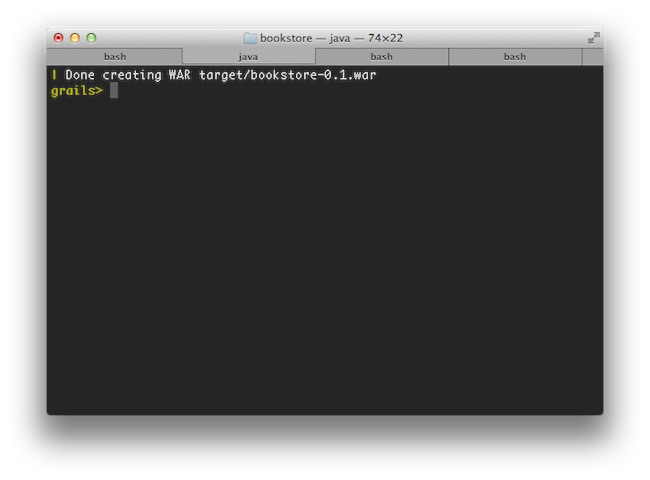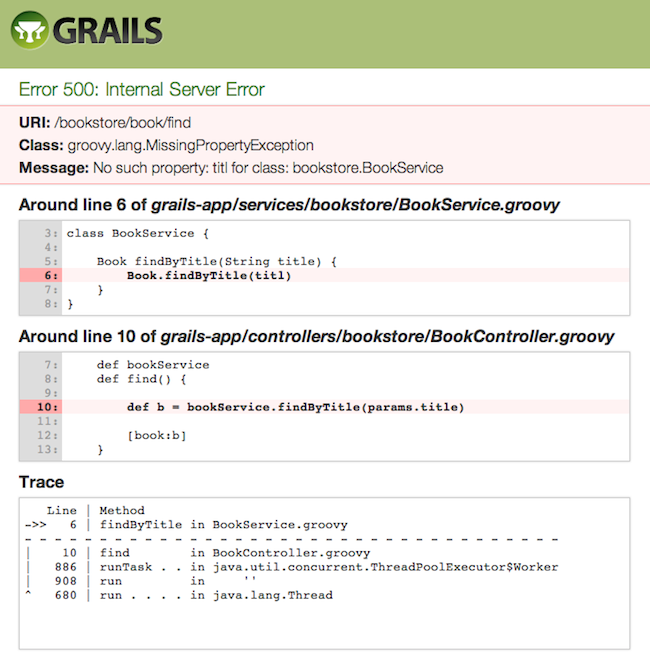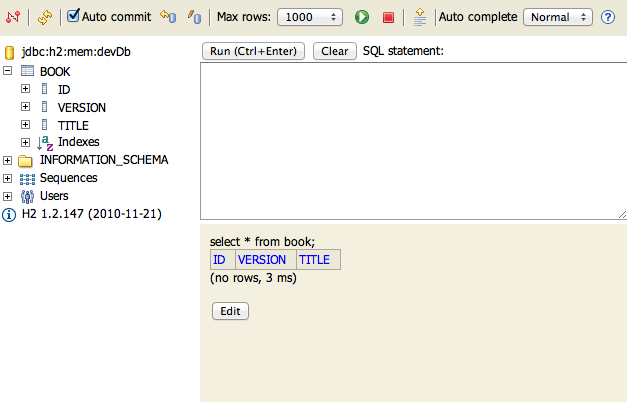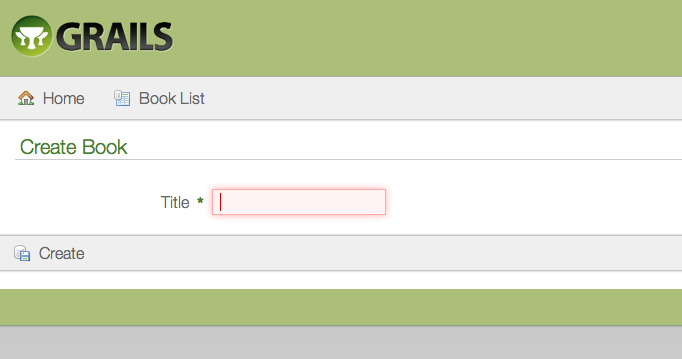(クイックリファレンス)
1 イントロダクション
Authors: Graeme Rocher, Peter Ledbrook, Marc Palmer, Jeff Brown, Luke Daley, Burt Beckwith ,
Japanese Translation: T.Yamamoto, Japanese Grails Doc Translating Team
このドキュメントの内容はスナップショットバージョンを元に意訳されているため、一部現行バージョンでは未対応の機能もあります。
Version: 2.1.0.BUILD-SNAPSHOT
1 イントロダクション
Java web development as it stands today is dramatically more complicated than it needs to be. Most modern web frameworks in the Java space are over complicated and don't embrace the Don't Repeat Yourself (DRY) principles.
現在のJavaでのWeb開発は必要以上に複雑です。JavaのほとんどのWebフレームワークは複雑でDon't Repeat Yourself (DRY)ではありません。
Dynamic frameworks like Rails, Django and TurboGears helped pave the way to a more modern way of thinking about web applications. Grails builds on these concepts and dramatically reduces the complexity of building web applications on the Java platform. What makes it different, however, is that it does so by building on already established Java technologies like Spring and Hibernate.
Rails,Django,TurboGearsといったダイナミックフレームワークはWebアプリケーションの考え方をよりモダンな方へ導いてくれました。Grailsは、Spring、Hibernateといった既に確立したJavaテクノロジーで、それらのダイナミックフレームワーク概念に基づいてJava環境でのWebアプリケーション開発の複雑さを軽減させます。
Grails is a full stack framework and attempts to solve as many pieces of the web development puzzle through the core technology and its associated plugins. Included out the box are things like:
Grailsは、多くのコア・テクノロジーによるWeb開発でのパズルような断片をプラグインで連携させることで解決を試みたフルスタックフレームワークです。以下の内容をすぐに利用できます:
- An easy to use Object Relational Mapping (ORM) layer built on Hibernate
- An expressive view technology called Groovy Server Pages (GSP)
- A controller layer built on Spring MVC
- A command line scripting environment built on the Groovy-powered Gant
- An embedded Tomcat container which is configured for on the fly reloading
- Dependency injection with the inbuilt Spring container
- Support for internationalization (i18n) built on Spring's core MessageSource concept
- A transactional service layer built on Spring's transaction abstraction
- Hibernate上に構築された、簡単に利用できるオブジェクト・リレーショナル・マッピング(ORM)レイヤ
- 表現豊かなビューテクノロジーGroovy Server Pages (GSP)
- コントローラレイヤは Spring MVCを利用
- コマンドラインスクリプト環境にはGroovy版のAnt Gant
- リロード可能に設定された組込 Tomcat
- 組込 Spring による依存注入
- SpringのMessageSourceで実装された国際化(i18n)対応
- Springフレームワークのトランザクション概念によるサービスレイヤのトランザクション
All of these are made easy to use through the power of the
Groovy language and the extensive use of Domain Specific Languages (DSLs)
これら全ては、
Groovy と多くのDomain Specific Languages (DSL ドメイン特化言語)を活用して簡単に使用できるように実装されています。
This documentation will take you through getting started with Grails and building web applications with the Grails framework.
このドキュメントは、Grailsのスタートガイドと、GrailsでのWebアプリケーション構築を紹介します。
1.1 Grails 2.0の新機能
This section covers the new features that are present in 2.0 and is broken down into sections covering the build system, core APIs, the web tier, persistence enhancements and improvements in testing. Note there are many more small enhancements and improvements, these sections just cover some of the highlights.
このセクションでは、現在2.0に存在する新機能、ビルドシステム、コアAPI、Web階層、永続化関連の強化等に分類し掘り下げて紹介します。他にも向上、強化した内容が多数ありますが、ここではハイライト的に紹介してます。
1.1.1 開発環境機能
インタラクティブモードとコンソールの強化
Interactive Mode and Console Enhancements
Grails 2.0 features brand new console output that is more concise and user friendly to consume. An example of the new output when running tests can be seen below:
Grails 2.0では、より簡潔でユーザフレンドリな、新コンソール出力を実装しました。以下の例はテストを実行した内容です。

In general Grails makes its best effort to display update information on a single line and only present the information that is crucial. This means that while in previous versions of Grails the
war command produced many lines of output, in Grails 2.0 only 1 line of output is produced:
コマンド実行の際に、重要な情報のみ1行を更新表示するようになりました。例えば、以前のバージョンまでは、warコマンドを実行すると大量のログが表示されていましたが、2.0からは1行だけで表示されます。

In addition simply typing 'grails' at the command line activates the new interactive mode which features TAB completion, command history and keeps the JVM running to ensure commands execute much quicker than otherwise
さらに、単にgrailsコマンドをコンソールで実行するだけで、新しいインタラクティブモードが開始され、JVMが起動したままとなりコマンドが迅速に実行でき、タブ補完、コマンド履歴も使用できます。

For more information on the new features of the console refer to the section of the user guide that covers the
console and interactive mode.
詳しい情報は、ユーザガイドのコンソールとインタラクティブモードを参照してください。
インタラクティブモード.
リロードエージェント
Reloading Agent
Grails 2.0 reloading mechanism no longer uses class loaders, but instead uses a JVM agent to reload changes to class files. This results in greatly improved reliability when reloading changes and also ensures that the class files stored in disk remain consistent with the class files loaded in memory, which reduces the need to run the
clean command.
Grails 2.0からのリロード機能は、クラスローダを使用せずJVMエージェントを使用してクラスファイルのリロードを行います。その結果、変更保存されたクラスが確実にメモリにロードされようになり、変更時のリロードが大いに向上しました。今までより、cleanコマンドの実行回数を減らすことができます。
新テストレポートとドキュメントテンプレート
New Test Report and Documentation Templates
There are new templates for displaying test results that are clearer and more user friendly than the previous reports:
以前のレポートよりクリーンでユーザフレンドリーなテストリポートテンプレートに変更されました:

In addition, the Grails documentation engine has received a facelift with a new template for presenting Grails application and plugin documentation:
さらに、アプリケーションやプラグインで使用する、Grailsドキュメントエンジンのテンプレートもリニューアルされました:

詳細はドキュメントエンジンのセクションを参照してください。
プロジェクト・ドキュメントプロジェクトドキュメントでの目次
Use a TOC for Project Docs
The old documentation engine relied on you putting section numbers into the gdoc filenames. Although convenient, this effectively made it difficult to restructure your user guide by inserting new chapters and sections. In addition, any such restructuring or renaming of section titles resulted in breaking changes to the URLs.
You can now use logical names for your gdoc files and define the structure and section titles in a YAML table-of-contents file, as described in the section on the
documentation engine. The logical names appear in the URLs, so as long as you don't change those, your URLs will always remain the same no matter how much restructuring or changing of titles you do.
Grails 2.0 even provides a
migrate-docs command to aid you in migrating existing gdoc user guides.
エラーレポートと分析表示の強化
Enhanced Error Reporting and Diagnosis
Error reporting and problem diagnosis has been greatly improved with a new errors view that analyses stack traces and recursively displays problem areas in your code:
スタックトレース分析、コード内の位置表示など、エラーレポートと分析表示が向上しました:

In addition stack trace filtering has been further enhanced to display only relevant trace information:
そして、さらにスタックトレースフィルターが強化され、関係のあるトレースのみが表示されるようになりました:
Line | Method
->> 9 | getValue in Book.groovy
- - - - - - - - - - - - - - - - - - - - - - - - -
| 7 | getBookValue in BookService.groovy
| 886 | runTask . . in ThreadPoolExecutor.java
| 908 | run in ''
^ 662 | run . . . . in Thread.java
H2データベースとDBコンソール
H2 Database and Console
Grails 2.0 now uses the H2 database instead of HSQLDB, and enables the H2 database console in development mode (at the URI /dbconsole) so that the in-memory database can be easily queried from the browser:
Grails 2.0では、今までのHSQLDBに代わりH2データベースを使用します。H2データベース付属のコンソール機能を開発モードで有効にしています。(URI /dbconsoleで表示可能) メモリ動作のデータベースでも簡単にブラウザからクエリ実行することができます:

プラグイン使用数等のトラッキング機能
Plugin Usage Tracking
To enhance community awareness of the most popular plugins an opt-in plugin usage tracking system has been included where users can participate in providing feedback to the plugin community on which plugins are most popular.
どのプラグインが人気があるのか等の情報を収集する。プラグイン使用レポートを収集する機能が実装されました。今後のプラグインサポートや、人気の無いプラグインの今後の努力などに役立てます。
This will help drive the roadmap and increase support of key plugins while reducing the need to support older or less popular plugins thus helping plugin development teams focus their efforts.
下位互換の対応を減らしている主なプラグインや、人気の無いプラグイン等の開発者が成果を確認して、今後のサポート向上とロードマップの進行を手助けになります。
依存管理機能改善
Dependency Resolution Improvements
There are numerous improvements to dependency resolution handling via Ivy including:
Ivyでハンドリングされている依存管理機能に多くの改善をしました:
- Grails now makes a best effort to cache the previous resolve and avoid resolving again unless you change
BuildConfig.groovy.
- Plugins dependencies now appear in the dependency report generated by
grails dependency-report
- Plugins published with the release plugin now publish their transitive plugin dependencies in the generated POM which are later resolved.
- It is now possible to customize the ivy cache directory via
BuildConfig.groovy
- Grailsは、
BuildConfig.groovy を変更しない限り前回の依存解決した内容を再解決させないように前回の内容をキャッシュするようになりました。
- プラグイン依存関係も
grails dependency-report のレポートに現れるようになりました。
- release-plugin で発行されたプラグインは、推移的なプラグイン依存をPOMに発行するようになりました。
- ivyキャッシュ用ディレクトリを
BuildConfig.groovy で変更できます。
grails.project.dependency.resolution = {
cacheDir "target/ivy-cache"
}* You can change the ivy cache directory for all projects via settings.groovy
settings.groovyに設定することで、全てのプロジェクトのivyキャッシュディレクトリを変更できます。
grails.dependency.cache.dir = "${userHome}/.ivy2/cache"* It is now possible to completely disable resolution from inherited repositories (repositories defined by other plugins):
- リポジトリの引継を完全に無効にできます(他のプラグインで定義されている場合等):
grails.project.dependency.resolution = { repositories {
inherits false // Whether to inherit repository definitions from plugins
…
}
…
}* It is now possible to easily disable checksum validation errors:
grails.project.dependency.resolution = {
checksums false // whether to verify checksums or not
}1.1.2 コア機能
バイナリプラグイン
Binary Plugins
Grails plugins can now be packaged as JAR files and published to standard maven repositories. This even works for GSP and static resources (with resources plugin 1.0.1). See the section on
Binary plugins for more information.
Grailsプラグインは、JARファイルとしてパッケージして、Mavenリポジトリへ発行できるようになりました。GSPや静的リソースでも可能です。詳しくは、
バイナリプラグイン のセクションを参考にしてください。
Groovy 1.8
Groovy 1.8
Grails 2.0は、多くの新機能と向上をしたGroovy 1.8がバンドルされています。
Groovy 1.8 リリースノートSpring 3.1 プロファイルサポート
Spring 3.1 Profile Support
Grails' existing environment support has been bridged into the Spring 3.1 profile support. For example when running with a custom Grails environment called "production", a Spring profile of "production" is activated so that you can use Spring's bean configuration APIs to configure beans for a specific profile.
Grailsの環境サポートがSpring 3.1プロフィールサポートとブリッジできます。例えば、Grailsの環境で"production"で動作している場合、Springプロフィール"production"がアクティベートされます。これによって、Springビーン定義APIでのビーン定義でプロフィールを指定できます。
1.1.3 Web機能
コントローラのアクションにメソッドを利用
Controller Actions as Methods
It is now possible to define controller actions as methods instead of using closures as in previous versions of Grails. In fact this is now the preferred way of expressing an action. For example:
以前のクロージャで記述していたコントローラアクションをメソッドで記述可能になりました。これからはメソッド記述を推奨します。:
// メソッドのアクション (action as a method)
def index() {}
// クロージャのアクション (action as a closure)
def index = {}アクションに引数を指定してバインド
Binding Primitive Method Action Arguments
It is now possible to bind form parameters to action arguments where the name of the form element matches the argument name. For example given the following form:
フォームエレメントのname属性を、アクションメソッドの引数に指定する方法でのバインドが可能になりました。 次のようなフォームを例に:
<g:form name="myForm" action="save">
<input name="name" />
<input name="age" />
</g:form>You can define an action that declares arguments for each input and automatically converts the parameters to the appropriate type:
以下のように、それぞれを引数として定義、パラメータの型も自動で適した型に変換します:
def save(String name, int age) {
// remaining
}静的リソース抽象化
Static Resource Abstraction
A new
static resource abstraction is included that allows declarative handling of JavaScript, CSS and image resources including automatic ordering, compression, caching and gzip handling.
JavaScript、CSS、画像などのリソースを管理、圧縮、キャッシュ、gzipを行う
静的リソース抽象化機能 が追加されました。
サーブレット3.0の非同期処理
Servlet 3.0 Async Features
Grails now supports Servlet 3.0 including the Asynchronous programming model defined by the specification:
Grailsはサーブレット3.0をサポートしました。サーブレット3.0での機能、非同期処理が使用可能です:
def index() {
def ctx = startAsync()
ctx.start {
new Book(title:"The Stand").save()
render template:"books", model:[books:Book.list()]
ctx.complete()
}
}リンク生成API
Link Generation API
A general purpose LinkGenerator class is now available that is usable anywhere within a Grails application and not just within the context of a controller. For example if you need to generate links in a service or an asynchronous background job outside the scope of a request:
全面的に使用可能なリンク生成API
LinkGenerator クラスが追加されました。コントローラのコンテキスト以外のどこからでも使用できます。例としてサービス、バックグラウンド処理、非同期タスク、リクエスト以外の場所でリンクが生成できます。
LinkGenerator grailsLinkGeneratordef generateLink() {
grailsLinkGenerator.link(controller:"book", action:"list")
}ページレンダリングAPI
Page Rendering API
Like the LinkGenerator the new PageRenderer can be used to render GSP pages outside the scope of a web request, such as in a scheduled job or web service. The PageRenderer class features a very similar API to the render method found within controllers:
LinkGenerator と同じく新規に追加されたAPI、
PageRenderer は、Webリクエスト以外の場所で、GSPページが描写可能です。例えば、Webサービス、スケジュールジョブなどで使用します。
PageRenderer サービスはコントローラの
render メソッドと同じように使用します。
grails.gsp.PageRenderer groovyPageRenderervoid welcomeUser(User user) {
def contents = groovyPageRenderer.render(view:"/emails/welcomeLetter", model:[user: user])
sendEmail {
to user.email
body contents
}
}The PageRenderer service also allows you to pre-process GSPs into HTML templates:
PageRenderer sサービスはGSPからHTMLを生成するのも可能です。
new File("/path/to/welcome.html").withWriter { w ->
groovyPageRenderer.renderTo(view:"/page/content", w)
}フィルター除外機能
Filter Exclusions
Filters may now express controller, action and uri exclusions to offer more options for expressing to which requests a particular filter should be applied.
フィルターでのコントローラ・アクション・URIの除外指定が実装されました。
filter1(actionExclude: 'log*') {
before = {
// …
}
}
filter2(controllerExclude: 'auth') {
before = {
// …
}
}filter3(uriExclude: '/secure*') {
before = {
// …
}
}パフォーマンスの向上
Performance Improvements
Performance of GSP page rendering has once again been improved by optimizing the GSP compiler to inline method calls where possible.
再度最適化したGSPコンパイラでGSPのパフォーマンスはさらに向上しました。
HTML5スカッフォルド
HTML5 Scaffolding
There is a new HTML5-based scaffolding UI:
HTML5ベースのスカッフォールドUIになりました:

jQueryがデフォルトになりました
jQuery by Default
The jQuery plugin is now the default JavaScript library installed into a Grails application. For backwards compatibility a
Prototype plugin is available. Refer to the
documentation on the Prototype plugin for installation instructions.
jQueryプラグインがデフォルトのJavaScriptライブラリとしてGrailsアプリケーションにインストールされます。 下位互換として、Prototypeはプラグインとして提供しています。 Prototypeついてはプラグインのドキュメントを参考にしてください。
Prototype plugin簡単な日付解析
Easy Date Parsing
A new date method has been added to the params object to allow easy, null-safe parsing of dates:
paramsオブジェクトのnullセーフメソッドに日付用の
dateが追加されました。
def val = params.date('myDate', 'dd-MM-yyyy')// or a list for formats
def val = params.date('myDate', ['yyyy-MM-dd', 'yyyyMMdd', 'yyMMdd'])// or the format read from messages.properties via the key 'date.myDate.format'
def val = params.date('myDate')URLフォーマットのカスタマイズ
The default URL Mapping mechanism supports camel case names in the URLs. The default URL for accessing an action named
addNumbers in a controller named
MathHelperController would be something like
/mathHelper/addNumbers. Grails allows for the customization of this pattern and provides an implementation which replaces the camel case convention with a hyphenated convention that would support URLs like
/math-helper/add-numbers. To enable hyphenated URLs assign a value of "hyphenated" to the
grails.web.url.converter property in
grails-app/conf/Config.groovy.
// grails-app/conf/Config.groovygrails.web.url.converter = 'hyphenated'
Arbitrary strategies may be plugged in by providing a class which implements the
UrlConverter interface and adding an instance of that class to the Spring application context with the bean name of
grails.web.UrlConverter.BEAN_NAME. If Grails finds a bean in the context with that name, it will be used as the default converter and there is no need to assign a value to the
grails.web.url.converter config property.
// src/groovy/com/myapplication/MyUrlConverterImpl.groovypackage com.myapplicationclass MyUrlConverterImpl implements grails.web.UrlConverter { String toUrlElement(String propertyOrClassName) {
// return some representation of a property or class name that should be used in URLs…
}
}// grails-app/conf/spring/resources.groovybeans = {
"${grails.web.UrlConverter.BEAN_NAME}"(com.myapplication.MyUrlConverterImpl)
}1.1.4 永続化機能
GORM API
The GORM API
The GORM API has been formalized into a set of classes (GormStaticApi, GormInstanceApi and GormValidationApi) that get statically wired into every domain class at the byte code level. The result is better code completion for IDEs, better integration with Java and the potential for more GORM implementations for other types of data stores.
GORM APIは、
GormStaticApi 、
GormInstanceApi 、
GormValidationApi というクラスに置き換えられたことによって、全てのドメインのバイトコードレベルに注入されます。この実装でIDEでのコード補完、Javaとの統合、様々なデータストアへのGORM実装への可能性が向上しました。
DetachedクライテリアとWhereクエリー
Detached Criteria and Where Queries
Grails 2.0 features support for
DetachedCriteria which are criteria queries that are not associated with any session or connection and thus can be more easily reused and composed:
def criteria = new DetachedCriteria(Person).build {
eq 'lastName', 'Simpson'
}
def results = criteria.list(max:4, sort:"firstName")To support the addition of
DetachedCriteria queries and encourage their use a new
where method and DSL has been introduced to greatly reduce the complexity of criteria queries:
def query = Person.where {
(lastName != "Simpson" && firstName != "Fred") || (firstName == "Bart" && age > 9)
}
def results = query.list(sort:"firstName")See the documentation on
DetachedCriteria and
Where Queries for more information.
新findOrCreateとfindOrSaveメソッド
New findOrCreate and findOrSave Methods
Domain classes have support for the findOrCreateWhere, findOrSaveWhere, findOrCreateBy and findOrSaveBy query methods which behave just like findWhere and findBy methods except that they should never return null. If a matching instance cannot be found in the database then a new instance is created, populated with values represented in the query parameters and returned. In the case of findOrSaveWhere and findOrSaveBy, the instance is saved before being returned.
ドメインクラスに、findWhereやfindByメソッドに似た、nullを返さない、findOrCreateWhere, findOrSaveWhere, findOrCreateBy, findOrSaveByのクエリーをサポートしました。実行結果にインスタンスが見つからない場合は、指定された値で、新規にインスタンスを作成して返します。findOrSaveWhereとfindOrSaveByの場合はインスタンスを保存してからインスタンスを返します。
def book = Book.findOrCreateWhere(author: 'Douglas Adams', title: "The Hitchiker's Guide To The Galaxy")
def book = Book.findOrSaveWhere(author: 'Daniel Suarez', title: 'Daemon')
def book = Book.findOrCreateByAuthorAndTitle('Daniel Suarez', 'Daemon')
def book = Book.findOrSaveByAuthorAndTitle('Daniel Suarez', 'Daemon')抽象クラス継承のサポート
Abstract Inheritance
GORM now supports abstract inheritance trees which means you can define queries and associations linking to abstract classes:
GORMが抽象クラス継承階層をサポートしました。これによって、関連リンクやクエリ等を抽象クラスに定義することができます:
abstract class Media {
String title
…
}
class Book extends Media {
}
class Album extends Media {}
class Account {
static hasMany = [purchasedMedia:Media]
}..def allMedia = Media.list()複数データソースサポート
Multiple Data Sources Support
It is now possible to define multiple datasources in DataSource.groovy and declare one or more datasources a particular domain uses by default:
DataSource.groovyに複数データソースの定義が可能になり、特定のドメインに複数のデータソースが設定できます:
class ZipCode { String code static mapping = {
datasource 'ZIP_CODES'
}
}If multiple datasources are specified for a domain then you can use the name of a particular datasource as a namespace in front of any regular GORM method:
複数のデータソースを定義したドメインでは、GORMメソッドの前にネームスペースとしてデータソース名を定義することで特定した実行が可能です:
def zipCode = ZipCode.auditing.get(42)
詳しくは
複数データソース を参照してください。
データベースマイグレーション
Database Migrations
A new
database migration plugin has been designed and built for Grails 2.0 allowing you to apply migrations to your database, rollback changes and diff your domain model with the current state of the database.
データベースマイグレーションを行うプラグインが、Grails 2.0用にデザイン構築されました。現行の状況との違いや、変更のロールバックがデータベースマイグレーションで可能になります。
database migration pluginデータベースリバースエンジニアリング
Database Reverse Engineering
A new
database reverse engineering plugin has been designed and built for Grails 2.0 that allows you to generate a domain model from an existing database schema.
データベースリバースエンジニアリングを行うプラグインが、Grails 2.0用にデザイン構築されました。既存のデータベーススキーマからドメインクラスを生成可能とします。
database reverse engineeringHibernate 3.6
Hibernate 3.6
Grails 2.0 is now built on Hibernate 3.6
Grails 2.0では、Hibernate 3.6を使用しています。
Bagコレクション
Bag Collections
You can now use Hibernate
Bags for mapped collections to avoid the memory and performance issues of loading large collections to enforce
Set uniqueness or
List order.
SetのユニークまたはListの順序必要としない場合でにおいて、大きなコレクションロードのメモリーとパフォーマンス問題を回避できるコレクションマッピング、Hibernate
Bagが使用できるようになりました。
詳しくは
セット、リスト、マップ を参照してください。
1.1.5 テスト機能
新Unitテストのコンソール出力
New Unit Testing Console Output
Test output from the test-app command has been improved:
test-app実行時のテストコンソール出力が向上しました:

新しいUnitテストAPI
New Unit Testing API
There is a new unit testing API based on mixins that supports JUnit 3, 4 and Spock style tests (with Spock 0.6 and above). Example:
JUnit3,4,Spock(Spock 0.6以上)のテストに対応した、Mixinsベースの新しUnitテストAPIが追加されました:
import grails.test.mixin.TestFor@TestFor(SimpleController)
class SimpleControllerTests {
void testIndex() {
controller.home() assert view == "/simple/homePage"
assert model.title == "Hello World"
}
}
テストのドキュメントが、この新しいフレームワークのために書き直されました。詳細は
テストのドキュメント を参照してください。
GORMのUnitテスト
Unit Testing GORM
A new in-memory GORM implementation is present that supports many more features of the GORM API making unit testing of criteria queries, named queries and other previously unsupported methods possible.
メモリ上で動作するGORM実装により、今までにサポートされていなかった、クライテリアクエリ、名前付きクエリなど、様々なGORM APIのテストがUnitテストで可能になりました。
インタラクティブモードで快速なUnitテストを
Faster Unit Testing with Interactive Mode
The new interactive mode (activated by typing 'grails') greatly improves the execution time of running unit and integration tests.
'grails'と入力するだけで実行できるインタラクティブモードでのUnitテスト・統合テストの実行速度が向上しました。
Unit Test スカッフォルド
Unit Test Scaffolding
A unit test is now generated for scaffolded controllers
スカッフォルドされたコントローラのUnitテストが生成されるようになりました。
 コマンド実行の際に、重要な情報のみ1行を更新表示するようになりました。例えば、以前のバージョンまでは、warコマンドを実行すると大量のログが表示されていましたが、2.0からは1行だけで表示されます。
コマンド実行の際に、重要な情報のみ1行を更新表示するようになりました。例えば、以前のバージョンまでは、warコマンドを実行すると大量のログが表示されていましたが、2.0からは1行だけで表示されます。 さらに、単にgrailsコマンドをコンソールで実行するだけで、新しいインタラクティブモードが開始され、JVMが起動したままとなりコマンドが迅速に実行でき、タブ補完、コマンド履歴も使用できます。
さらに、単にgrailsコマンドをコンソールで実行するだけで、新しいインタラクティブモードが開始され、JVMが起動したままとなりコマンドが迅速に実行でき、タブ補完、コマンド履歴も使用できます。 詳しい情報は、ユーザガイドのコンソールとインタラクティブモードを参照してください。 インタラクティブモード.
詳しい情報は、ユーザガイドのコンソールとインタラクティブモードを参照してください。 インタラクティブモード. さらに、アプリケーションやプラグインで使用する、Grailsドキュメントエンジンのテンプレートもリニューアルされました:
さらに、アプリケーションやプラグインで使用する、Grailsドキュメントエンジンのテンプレートもリニューアルされました: 詳細はドキュメントエンジンのセクションを参照してください。 プロジェクト・ドキュメント
詳細はドキュメントエンジンのセクションを参照してください。 プロジェクト・ドキュメント そして、さらにスタックトレースフィルターが強化され、関係のあるトレースのみが表示されるようになりました:
そして、さらにスタックトレースフィルターが強化され、関係のあるトレースのみが表示されるようになりました:



